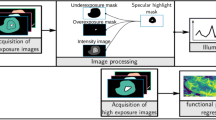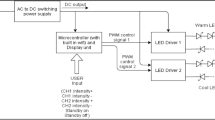Abstract
When surgeons evaluate the condition of organs and make diagnoses, color difference is an important information despite its subtleness. Yielding clearer views of blood circulation holds the key to successful surgeries such as transplants and anastomosis. Optimization of surgical illuminant is one approach to clearer views. Our previous study focused on computer simulation to enhance color difference. In the present study, we improved the simulation method by applying a color appearance model CIECAM02 and we realized an optimized illuminant based on the simulation. In an evaluation experiment comparing the optimal illuminant with the conventional illuminant, 14 LEDs fixed to the light unit were spectrally adjusted to demonstrate the two illuminants. Using a rat cecum, we observed the color differences under two conditions: normal blood flow and restricted blood flow. The color difference under the optimal illuminant was greater than under the conventional illuminant and the effectiveness of the optimal illuminant was confirmed.








Similar content being viewed by others
References
Akbari H (2010) Detection and analysis of the intestinal ischemia using visible and invisible hyperspectral imaging. IEEE Trans Bio Eng 57(8):2011–2017
Zuzak KJ, Francis RP, Wehner EF, Litorja M, Cadeddu JA, Livingston EH (2011) Active DLP hyperspectral illumination: a noninvasive, in vivo, system characterization visualizing tissue oxygenation at near video rates. Ana Chem 83(19):7424–7430
Bartczak P, Fält P, Penttinen N, Ylitepsa P, Laaksonen L, Lensu L, Hauta-Kasari M, Uusitalo H (2017) Spectrally optimal illuminations for diabetic retinopathy detection in retinal imaging. Opt Rev 24(2):105–116
Wang H, Yung-Tsan C (2012) Optimal lighting of RGB LEDs for oral cavity detection. Opt Express 20(9):10186–10199
Litorja M, Brown SW, Lin C, Ohno Y (2009) Illuminants as visualization tool for clinical diagnostics and surgery. Proc. SPIE 7169, National Institute of Standards and Technology, CA, USA
Wang HC, Tsai MT, Chiang CP (2013) Visual perception enhancement for detection of cancerous oral tissue by multi-spectral imaging. J Opt 15(5):055301
Liu P, Wang H, Zhang Y, Shen J, Wu R, Zheng Z, Li H, Liu X (2014) Investigation of self-adaptive LED surgical lighting based on entropy contrast enhancing method. Opt Comm 319:133–140
Shen J, Wang H, Wu Y, Li A, Chen C, Zheng Z (2015) Surgical lighting with contrast enhancement based on spectral reflectance comparison and entropy analysis. J Biomed Opt 20(10):105012
Murai K, Kawahira K, Haneishi H (2013) Improving color appearance of organ in surgery by optimally designed LED illuminant. In: Long M (ed) World Congress on Medical Physics and Biomedical Engineering May 26–31, 2012, Beijing, China, vol 39. Springer, Berlin, Heidelberg, pp 1010–1013
Luo MR, Li C (2013) CIECAM02 and its recent developments. In: Advanced color image processing and analysis. Springer, Wiley, New York, pp 19–58
Kennedy J (2011) Particle swarm optimization. Encyclopedia of machine learning. Springer, New York, pp 760–766
Wyszecki G, Stiles WS (1982) Color science, 2nd edn. Wiley, New York
Acknowledgements
This research was partly supported by KAKENHI, the Grant-in-Aid for Scientific Research (A), Grant number 16H01855, and JSPS Core-to-Core Program A. Advanced Research Networks.
Author information
Authors and Affiliations
Corresponding author
Appendix: formula of CIECAM02
Appendix: formula of CIECAM02
As a first step to calculate color difference, tri-stimulus values were modified to the CAT 02 space, R, G, B, which is one of the color uniformity spaces, and written as follows:
The D factor for adaption degree is defined as follows:
The adaption luminance \({L_{\text{A}}}\) is defined as illumination luminance divided by 5\(\pi\). In this paper, we set \({L_A}={\text{20,000}}~{\text{lx}}\) and \(F=1\). Then D is given by 0.87. Using the CAT02 uniform space value and the D factor, we define the full chromatic adaption transform as follows:
where \({R_{\text{W}}},\;{G_{\text{W}}},\;{B_{\text{W}}}\) are CAT02 values of illumination. The full chromatic adaption values are converted to the Hunt–Pointer–Estevez space before the post-adaption nonlinear response compression as follows:
For nonlinear compression, parameters k, \({F_L}\), n, and \({N_{bb}}\) which are related to the surrounding environment are calculated using the following formulae:
Using these parameters, we express the nonlinear compression as follows:
Preliminary Cartesian coordinates a, b are calculated to obtain hue angle h:
The achromatic response A is defined as follows:
Using these values, we calculate target lightness J under the illuminant as follows:
where \({A_{\text{W}}}\) is the achromatic response of the illuminant. In this paper, we set c to 0.69 corresponding to an average environment. The chroma value C and the colorfulness value M are calculated as follows:
The parameters for coefficients values, \({c_1}\), \({c_2}\), and \({K_L}\), are defined as uniform color space values: \({c_1}=0.007,\;{c_2}=0.0228,\;{K_L}=1.00\). Color differences by CIECAM02 are defined as follows:
Color difference value in the CIECAM02 color appearance model is defined using lightness value J′ and Cartesian coordinates \({a_M}^{\prime }\), \({b_M}^{\prime }~\)as follows:
About this article
Cite this article
Kurabuchi, Y., Murai, K., Nakano, K. et al. Optimal design of illuminant for improving intraoperative color appearance of organs. Artif Life Robotics 24, 52–58 (2019). https://doi.org/10.1007/s10015-018-0438-x
Received:
Accepted:
Published:
Issue Date:
DOI: https://doi.org/10.1007/s10015-018-0438-x




